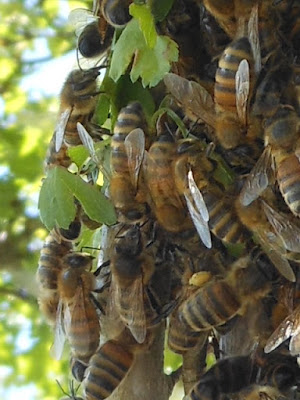Swarming is a joyful time for the bees, when half the colony leaves the nest with the old laying queen to find a new home...
...leaving behind a peanut shaped capped queen cell for the remaining bees to care for.
(That’s next month’s story)
If nobody comes to collect them, they fly off again together, swirling through the air to make a nest in their new found location, which could be an empty hive...
Or, If the weather changes, they often make their nest where they are – in a Cotoneaster hedge in this case;
A fantastic construction, but they are entirely at the mercy of the weather and they would be unlikely to survive.
The cluster of bees contains a variety of ages, some of which would have been returning from foraging expeditions with pollen and nectar when the swarm emerged from the hive. This will last them for about 3 days.
Settled swarm on Hawthorn, Ashley's Field
The best method in this case was to put a cardboard box over the top of the swarm...
....then gently smoke them up into it.
The bees use a branch to bridge across the gap and begin to go up into the box.
Just a quick look in the box…
As the bees hook onto each other from the top of the box, we can turn it upside down without disturbing them and place it on a sheet with a stick to make an entrance for them. No expense spared!
They fan their wings and send the scent (from their nasonov gland in the final section of their abdomen) into the air, to call in all the stragglers.
Ah, this a much better picture of fanning:
Nasonov gland visible as the lighter section near the tip of the abdomen
At dusk, when they have all found their way into the box, it’s wrapped up in the sheet and the bees are taken away, gently but firmly shaken from the box into a clean hive, the new frames carefully lowered on top of them and the hive closed up with an entrance left open. It’s a great time to have some help from my young apprentice!
The bees cluster together on the new frames and use the pollen and nectar, which they brought with them as stores...
...to fuel the energy they need to make beeswax in the glands under their abdomen...
...while the foraging bees continue to bring in food from the May flowers.
Hawthorn (Crataegus monogyna)
Holly (Ilex aquifolium), the tiniest of flowers has a good source of pollen and nectar for the bees
Gillybee X


























No comments :
Post a Comment